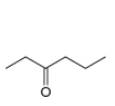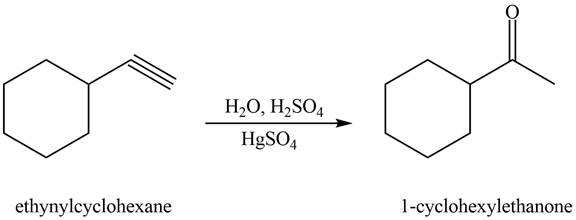
Concept explainers
What
a.  b
b . c.
. c.  d.
d. 
(a)
Interpretation: The alkynes that forms the given ketone as the only product after hydration with
Concept introduction: A terminal alkyne reacts with
Answer to Problem 11.36P
The alkynes that forms the given ketone as the only product after hydration with
Explanation of Solution
The alkynes that forms the given ketone as the only product after hydration with

Figure 1
The terminal alkynes,
The alkynes that forms the given ketone as the only product after hydration with
(b)
Interpretation: The alkynes that forms the given ketone as the only product after hydration with
Concept introduction: A terminal alkyne reacts with
Answer to Problem 11.36P
The alkyne that forms the given ketone as the only product after hydration with
Explanation of Solution
The alkyne that forms the given ketone as the only product after hydration with

Figure 2
The terminal alkyne, ethynylcyclohexane reacts with the reagents
The alkyne that forms the given ketone as the only product after hydration with
(c)
Interpretation: The alkynes that forms the given ketone as the only product after hydration with
Concept introduction: A terminal alkyne reacts with
Answer to Problem 11.36P
The alkynes that forms the given ketone as the only product after hydration with
Explanation of Solution
The alkynes that forms the given ketone as the only product after hydration with

Figure 3
The terminal alkynes,
The alkynes that forms the given ketone as the only product after hydration with
(d)
Interpretation: The alkynes that forms the given ketone as the only product after hydration with
Concept introduction: A terminal alkyne reacts with
Answer to Problem 11.36P
The alkynes that forms the given ketone as the only product after hydration with
Explanation of Solution
The alkynes that forms the given ketone as the only product after hydration with

Figure 4
The terminal alkynes,
The alkynes that forms the given ketone as the only product after hydration with
Want to see more full solutions like this?
Chapter 11 Solutions
Package: Loose Leaf for Organic Chemistry with Biological Topics with Connect Access Card
Additional Science Textbook Solutions
Campbell Biology (11th Edition)
Fundamentals of Anatomy & Physiology (11th Edition)
Genetics: From Genes to Genomes
Biology: Life on Earth (11th Edition)
Loose Leaf For Integrated Principles Of Zoology
Organic Chemistry
- Indicate the variation in conductivity with concentration in solutions of strong electrolytes and weak electrolytes.arrow_forwardThe molar conductivity of a very dilute solution of NaCl has been determined. If it is diluted to one-fourth of the initial concentration, qualitatively explain how the molar conductivity of the new solution will compare with the first.arrow_forwardWhat does the phrase mean, if instead of 1 Faraday of electricity, Q coulombs (Q/F Faradays) pass through?arrow_forward
- What characteristics should an interface that forms an electrode have?arrow_forwardFor a weak acid AcH, calculate the dissociated fraction (alpha), if its concentration is 1.540 mol L-1 and the concentration [H+] is 5.01x10-4 mol L-1.arrow_forwardIf the molar conductivity at infinite dilution of HAC is A0 = 390.5 S cm² mol¹. Calculate the Arrhenius conductivity of a 9.3% by weight solution of HAc with a pH of 3.3. Data: molecular weight of HAC is 60.05 g/mol and the density of the solution is 1 g/cm³.arrow_forward
- If the molar conductivity at infinite dilution of HAC is A0 = 390.5 S cm² mol¹. Calculate the Arrhenius conductivity of a 9.3% by weight solution of HAc with a pH of 3.3. Data: molecular weight of HAC is 60.05 g/mol and the density of the solution is 1 g/cm³.arrow_forwardIf the molar conductivity at infinite dilution of HAC is A0 = 390.5 S cm² mol¹. Calculate the Arrhenius conductivity of a 9.3% by weight solution of HAc with a pH of 3.3. Data: molecular weight of HAC is 60.05 g/mol and the density of the solution is 1 g/cm³.arrow_forwardDetermine the distance between the metal and the OHP layer using the Helm- holtz model when the electrode's differential capacitance is 145 μF cm². DATA: dielectric constant of the medium for the interfacial zone &r= lectric constant of the vacuum &0 = 8.85-10-12 F m-1 = 50, die-arrow_forward
- Describe a sequence of photophysical processes that can be followed by radiation adsorbed by a molecule in the ground state to give rise to phosphorescent emission.arrow_forwardState two similarities between fluorescence and phosphorescence.arrow_forwardState three photophysical processes that can be related to the effects of incident radiation on a molecule in its ground state. Consider that radiation can give rise to fluorescent emission, but not phosphorescent emission.arrow_forward
 ChemistryChemistryISBN:9781305957404Author:Steven S. Zumdahl, Susan A. Zumdahl, Donald J. DeCostePublisher:Cengage Learning
ChemistryChemistryISBN:9781305957404Author:Steven S. Zumdahl, Susan A. Zumdahl, Donald J. DeCostePublisher:Cengage Learning ChemistryChemistryISBN:9781259911156Author:Raymond Chang Dr., Jason Overby ProfessorPublisher:McGraw-Hill Education
ChemistryChemistryISBN:9781259911156Author:Raymond Chang Dr., Jason Overby ProfessorPublisher:McGraw-Hill Education Principles of Instrumental AnalysisChemistryISBN:9781305577213Author:Douglas A. Skoog, F. James Holler, Stanley R. CrouchPublisher:Cengage Learning
Principles of Instrumental AnalysisChemistryISBN:9781305577213Author:Douglas A. Skoog, F. James Holler, Stanley R. CrouchPublisher:Cengage Learning Organic ChemistryChemistryISBN:9780078021558Author:Janice Gorzynski Smith Dr.Publisher:McGraw-Hill Education
Organic ChemistryChemistryISBN:9780078021558Author:Janice Gorzynski Smith Dr.Publisher:McGraw-Hill Education Chemistry: Principles and ReactionsChemistryISBN:9781305079373Author:William L. Masterton, Cecile N. HurleyPublisher:Cengage Learning
Chemistry: Principles and ReactionsChemistryISBN:9781305079373Author:William L. Masterton, Cecile N. HurleyPublisher:Cengage Learning Elementary Principles of Chemical Processes, Bind...ChemistryISBN:9781118431221Author:Richard M. Felder, Ronald W. Rousseau, Lisa G. BullardPublisher:WILEY
Elementary Principles of Chemical Processes, Bind...ChemistryISBN:9781118431221Author:Richard M. Felder, Ronald W. Rousseau, Lisa G. BullardPublisher:WILEY





